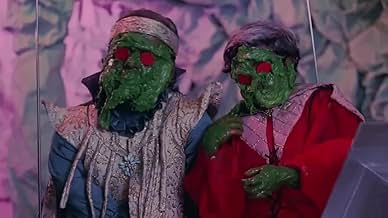Unlike the impetuous and frenetic direction by Curiel, Rafael Lanuza was much more traditionally static, more interested in the loony sets, kooky wardrobe and wacky effects. He delivered a film of extravagant framing and outlandish art direction, with comic-booky plots along the same lines (but approached differently) as the ones Curiel diffused with his touch.
While Superzan and the Space Child (1973) had a rather unorthodox execution, Lanuza adapted himself quite well to the wrestling subgenre with this outing, implementing the strange deviations, cartoony logic and artificial visuals the genre demands.
The clash between the styles of both filmmakers regarding the Campeones trilogy is quite evident. That which Curiel captured in a distant and alienated way, almost in an improvised manner, Lanuza instead directs it with a lot more shots thought a priori, more prominently using close ups and inserts. What Curiel saw from a distance Lanuza shoves it in your face and rejoices in it.
This third entry mixes some of the more prominent pillars of popular entertainment, not only the typical superhero comics or the sport and spectacle that's wrestling (both of them being already in the genre's DNA), but Lanuza in this picture adds the circus to it's combo, reimagining these battles involving masked heroes as a deranged circus act instead of a spectacle derived from the ring, making it's characters interact with circus scenery and having an audience present to be delighted by the battle antics. Perhaps because of this refreshing recontextualization, El triunfo de los campeones justicieros comes off as one of the most interesting cocktails of vulgar and common entertainment for the masses.
Incomprehensible science of unreal logic, jumping between dimensions and cheaply teleporting between spaces, taking advantage of its colorful paper mache backdrops and overall zany madness. The oddity of the genre unfolds with efficiency in this indescribable film that's one of its high points.






